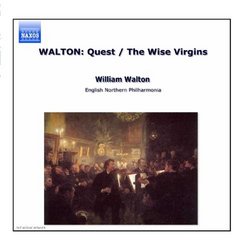New Aspects of Walton's Art Emerge
12/26/2002
(5 out of 5 stars)
"I've always admired William Walton in a modest way, now more so than ever, thanks to Lloyd-Jones's stimulating series of recordings on Naxos. The present CD is no exception. "The Quest," whose score was "lost" or rather misplaced for a number of years, emerges here as a major score. Written during World War II and based on Spenser's "The Faerie Queene," it is a ballet that betrays Walton's debt to other 20th-century ballet composers, notably Ravel and Stravinsky, though the ripe and piquant orchestration with its colorful use of percussion is Walton's own a la "Belshazzar's Feast." None of the jazzy interpolations from that score here, however. There are brief references to popular music and dance, but this is a more straight-laced work, as befits the spiritually weighty subject matter. Certainly the finest of its several fine scenes is the last, which takes place at the House of Holiness. The music works up to a grand apotheosis that recalls the last moments of Ravel's "Ma Mere L'Oye" and Stravinsky's "The Firebird," though the strange, flatted, carillon-like descending figure that dominates the very end--in a din of tubular bells--is pure Walton. It has that deliciously acid quality even his most triumphal music sometimes has--vide the First Symphony's finale.Much more familiar is "The Wise Virgins," one of Walton's greatest hits, a reorchestration of music from Bach's cantatas designed for a ballet based on the parable of the wise virgins from the Gospels. Lloyd-Jones and his ensemble, abetted by Naxos' fine sonics, do it full justice."Siesta," a work written in the 20's that Walton apparently had a fondness for throughout his life, is a strange little affair. Sort of like Bartok's "Interrupted Intermezzo" from the Concerto for Orchestra, Walton's languid little piece is punctuated by petulant thrusts from the orchestra. Bad dreams? Anyway, "Siesta" sounds like an outtake from Walton's satiric gem "Facade."All in all, some very accomplished music by an intriquing modern master."
Second-rate, but still attractive Walton, in very good perfo
G.D. | Norway | 04/04/2009
(4 out of 5 stars)
"The Quest, composed in 1943, was Walton's only ballet, and is a somewhat neglected work. The music is reminiscent of the music of his first symphony, wistfully atmospheric and consistently thematically inventive. It is, in the end, perhaps not one of his most memorable creations, but it is certainly skillfully wrought and thoroughly enjoyable with many interesting touches - not the least in terms of the excellent, light and airy orchestral textures. The Wise Virgins is overall less appealing, consisting as it does of arrangements of Bach (mostly from his cantatas and not always the most famous of Bach's works). It is, indeed, sensitively orchestrated, but doesn't really invite to repeated listening. Siesta is probably the most well-known work here, and it is an appealing little piece.
The performances by the English Northern Philharmonia under David Lloyd-Jones are uniformly excellent. The brisk and lively rhythms are superbly realized with snappy, characterful winds and brass and brilliantly light and clear string textures. Sound quality is also excellent, and this issue - while not containing any first-rate Walton - can be safely recommended."


 Track Listings (14) - Disc #1
Track Listings (14) - Disc #1